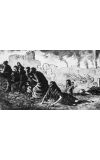
25 Jul 2011 09:12:55
The rejected paintings were transferred to the National Archives from the Ministry of Information, but have never been displayed until now. A selection will be shown in the archives' museum at Kew, taking their place beside the Domesday Book and Magna Carta.
In 1940 Peake, a genius best known for his trilogy Gormenghast, created the paintings showing mutilated, raped or starving victims of war atrocities, as he imagined Hitler might have drawn them.
Peake, who was already striving to become a formal war artist, proposed to the Ministry of Information that they be published as a propaganda leaflet, presented as an illustrated catalogue for an exhibition by Hitler, complete with a title page showing an artist's palette pierced by the barrel of a rifle, and banal titles such as "Family group" and "Still life" and "Reclining figure" for the shocking images. Surprisingly the government accepted the idea, paid the perennially broke artist 140 guineas for the works, and proposed to print 100,000 copies and distribute them across South America.
Within a few months there had been a change of heart, to Peake's disappointment: the paintings would never be used and, as he had sold them, he could neither exhibit nor publish them.
When his son Sebastian visited the archives this month, it was the first time he had seen the originals. "What is so extraordinary about my father's paintings is that he was creating these powerful images of ruined cities and devastated people, which would later become so familiar from films and photographs, out of the force of his own invention, years before any of these events had happened," he said.
Peake's biographer, Peter Winnington, believes the artist must have been inspired by Goya's Disasters of War etchings, but wrote: "There is something disturbing about the idea that these pictures were drawn entirely from Mervyn's imagination, as he sat in the relative comfort of his Suffolk cottage, long before he had seen anything of the horrors of war."He would go on to become a more conventional war artist, and produced drawings in the aftermath of the war, including from Bergen-Belsen concentration camp, for the magazine the Leader.
The Hitler album paintings were never published in full or exhibited, but sat for decades in the Ministry of Information files, which were then transferred to the old National Archives in Chancery Lane, and eventually to Kew. His son believes that inspiration for the paintings, and for much of the rest of his work, came from scenes Peake saw as a child in China, where he was born in 1911 when his doctor father was running a mission hospital in Hunan province. He died in 1968 after years in hospitals and mental asylums after physical and mental collapse blamed on Parkinson's disease and Encephalitis Lethargica (sleeping sickness) which he probably contracted in an epidemic in China.

